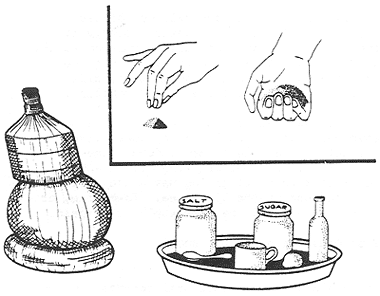Slide 16 (and="#Figure 6"> Figure 6)
Home made oral Fluids, and how much
to give
(Review Slide 9)
Here we show you how you can make your own oral rehydration fluids from things that you can find in most
homes. You do not have to wait for someone to send
you packets of ORS.
The drawings shows a 'home rehydration kit' from
Uganda. Your own kit would probably look very
different. The gourd contains water, which they have
boiled, and cooled. Notice that there is a banana leaf
cover over it to keep it clean. Where you work, people probably keep water in a different kind of
container.
What you use for the container is not important. (Reference
4)
Q. What is important about the water container and
what must you know about it?
A. The water container should be clean: it should
have a cover, and you should find some way of
measuring how much water it holds. You must
have some way of measuring a litre, or a little more
than a litre of water. If you do not put in enough
water, the salt in the rehydration fluid may be too
strong. This is very dangerous (see="#Further Discussion"> Further
Discussion), (For example, in some parts of
Kenya, people measure water in 1 kg. 'Kimbo'
cooking fat tins which hold a little more than a litre.)
Q. Which household substances do you use instead of
ORS? Not many people have glucose or potassium
chloride.
A. Use kitchen salt, and ordinary sugar. (They are in
the jars on the rehydration kit tray.)
Kitchen salt is sodium chloride which is the most
important of the three salts in "ORALYTE". To your
one litre or a tide more than one litre of water, add two three finger pinches of salt. Look at the
purple drawing
which is above the jar of salt. This hand is taking one three-finger pinch from
the pile of salt. The salt should
come up to the first finger crease, but not above it.
Add two of these pinches to your litre of water.
Ordinary sugar has the chemical name sucrose.
Sucrose helps the intestine to absorb salt and water
nearly as well as glucose does. Look at the other purple drawing above the jar of sugar. This hand is holding a
four-finger scoop of sugar. Add three four-finger
scoops of sugar to your litre of water.
If baking soda (sodium bicarbonate) is also available,
then add one three-finger pinch of baking soda to the
litre or so of water.
Always remind people to wash their hands before
preparing any food or drink.
Q. What else do you see on the tray?
A. A cup and spoon, to give the fluid to a child. There
is also an orange. You can use this (or any other citrus fruits) to make the drink taste nice. Also,
oranges contain potassium, so orange juice makes
the fluid more complete.
Most fruit juices contain potassium, and coconut
water and well-mashed banana are other useful
sources of potassium.
Figure 6 - A three-finger pinch and a four-finger
scoop. (Top of="#top"> Slide 16)

Further Discussion
-
Using sugar instead of glucose.
If you are
weighing sugar, you need 40 g of sugar per litre of
water. Notice that this is twice the weight of
glucose that you need.
-
Variation in "3-finger pinches"
We know from
preliminary studies that you have to change your
recommendations about hand measurements
according-to how people in your area us their
hands for cooking and eating, and also that you
have to relate your measurements to the usual size
of water container in the area and in the home.
These studies showed that the amount of salt that
people pick up in a three-finger pinch varies very
much. But this variation is not due to the size of
the person's fingers, or to the coarseness of the salt,
as we used to think. The variation is due to the
different ways in which people use their fingers to
pick up food. So, in each area you need to work
out the best local way of measuring the salt and
sugar to make a solution which contains 3.5 g. salt
and 40 g. sugar in each 1 litre of water. In
Bangladesh, mothers who were individually shown
and taught how to pinch up salt were able to do it
very accurately and consistently. In your area it
may be wise to seek advice about standardising the
method and teaching it.The main danger is that mothers sometimes put in
too much salt. (See="diarrhoea-management-18.htm" target="_blank">
Slide 18.)This danger is especially likely if a baby has been
bottle-fed with cow's milk, because cow's milk
also contains a lot of salt, and bottle-fed babies are
often already hypernatraemic when they come for
treatment.
-
Can you use contaminated water? Research has
shown that the micro organisms in contaminated
water usually do not multiply when ORS is mixed
in the water. If a child is dehydrated, use any
available water for preparing OR solution.Use the cleanest water that is available to you. Do
not contaminate water with dirty hands or vessels.
We believe that the benefits of early OR are greater
than the dangers of using dirty water. However,
once you have mixed them, OR fluids should not
be used after 24 hours.